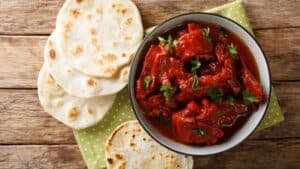The term curry evokes images of Indian cuisine that is flavorful and rich. It may even be said that curry reflects the personality of its own country. Although considered a hot dish already, some avid spicy food lovers wonder how to make curry even spicier? This article will discuss everything you need to know about that in detail.
Adding extra chili peppers is a simple method to make your curry spicier. Since curries get their spiciness from peppers – any chili peppers will increase the
Curry has evolved into more than just food throughout the years; it elicits an emotion of warmth while teasing your taste receptors and making your mouth water just thinking about it! Continue reading if you want to learn more about spicy curry.
7 Tips to Spice Up Your Curry
Are you looking for tips to
You may make a spicier, beautifully gratifying curry with a few basic strategies:
1. Begin Your Curry With A Fantastic Marinade
To make a fantastic curry sauce, you’ll need a great marinade. Marination with flavorful ingredients such as red pepper, minced garlic, and various masalas or
2. Make Use Of Whole Spices
The flavor of your curry will be richer if you use whole spices rather than ground spices. Because whole spices have a smaller total surface area than powdered spices, they lose less taste in the air.
To bring out the flavors in most whole spices, fry them briefly in oil or dry roast them before grinding them.
3. Fresh Chili
It is one of the easiest and quickest methods to make curry spicier. Chilies, either red or green, can be used. The seeds of most chiles are the most potent portion. Scrape out the seeds before using them if you prefer a milder chili flavor.
Simply finely chop each chili and add it to your recipe one at a time. This can be done in the middle of the cooking phase or immediately at the finish.
4. Mango Chutney
This is an actual secret ingredient for making the curry spicier. It only takes a teaspoon to get the job done. This terrific sugar replacement adds a nice roundness to the dish. The good news is that a jar is inexpensive, lasts a long time, and can even be used with poppadoms!
5. Make A Paste Using Fresh Garlic And Ginger.
Garlic burns rapidly, altering the flavor of your curry. Make a garlic and ginger paste with equal proportions of each to help prevent this and for a smoother curry sauce.
6. Chili Sauce
A chili sauce or hot sauce bottle is ideal for adding a dash of
- Habanero sauce
- Tabasco sauce
- Sriracha sauce
- Pure chili extract
7. Use Freshly Ground Black Pepper
The majority of the discussion about the heat in curries revolves around hot peppers; however, some curries benefit from the addition of freshly ground black pepper. Black pepper contributes a lot to the hot flavor of vindaloo curry.
It’s worth noting that the freshly ground component is crucial. Pre-ground black pepper has some taste, but it lacks the fire and depth of using excellent peppercorns that you grind right before using. For the finest results in a curry, use Tellicherry peppercorns.
Different Types of Curries: From Hottest To Mildest
Phaal curry
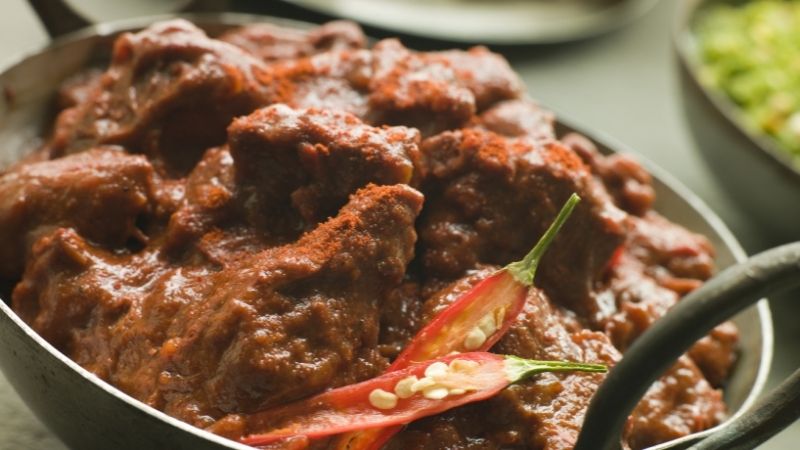
Phaal curry is a British-Indian cuisine recognized for being the hottest in the world, and it’s so hot at Brick Lane Curry House that the chef has to wear a gas mask to avoid inhaling the chili fumes.
Jalfrezi
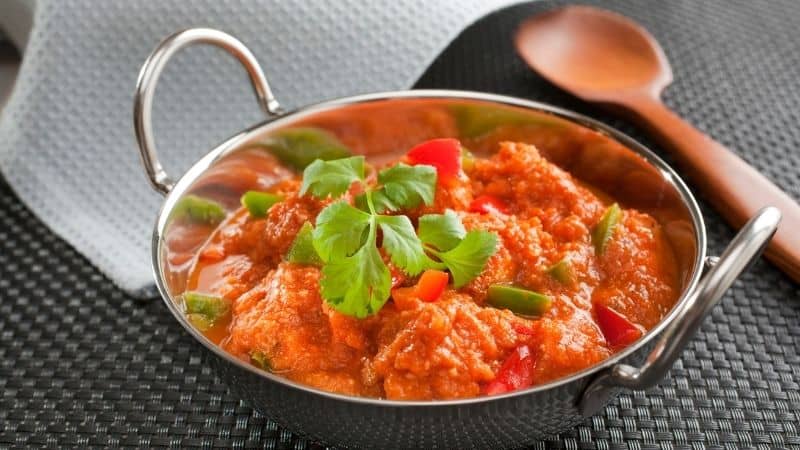
This is yet another famous curry in India. Coriander, cumin, and turmeric marinade meat, vegetables, and fish. Green chilies, cabbage, onions, and tomatoes are cooked in oil. The result is a thicker, dryer sauce with a strong flare of green heat when cooked down.
Bhuna
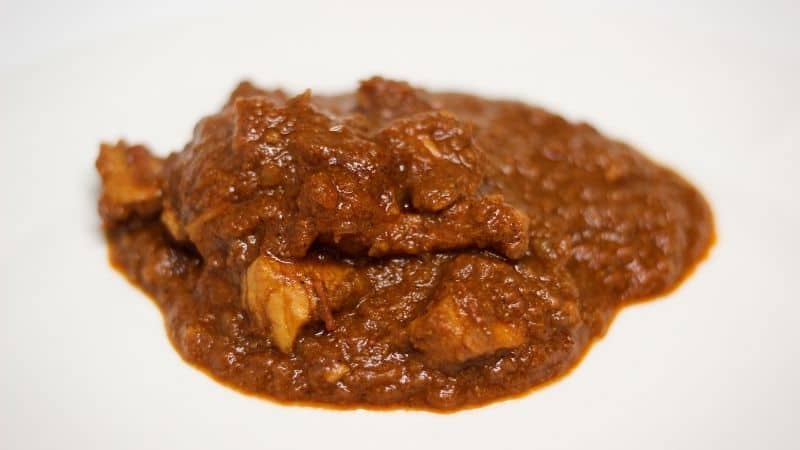
This Bengali curry is made by frying poultry, pork, or fish with spices at a high temperature. Frying or roasting is referred to as bhuna. Spices are used for frying chicken, beef, and fish. It’s then combined with extra spices and added to the onion tomato sauce. After that, it’s covered and left to cook. Meat, chicken, and fish, for example, release their own juice or water and cook in it.
Rogan Josh
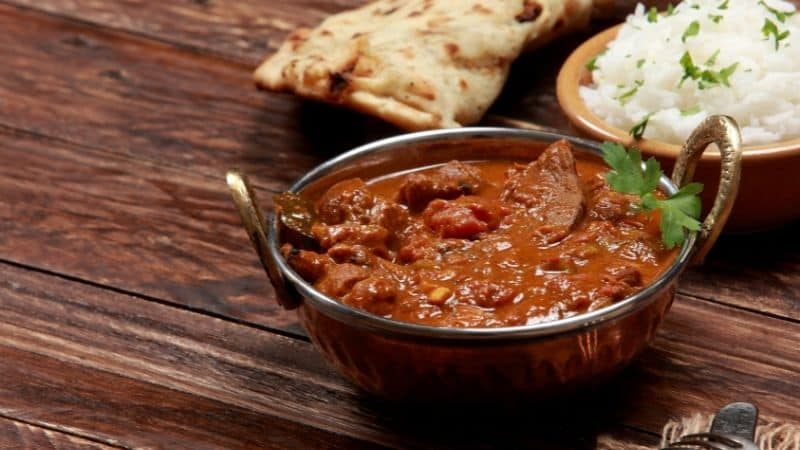
Rogan josh, or lamb cooked with Kashmiri chilies, is a show-stopper and the iconic curry of Kashmir. In this delectable dish, warm cloves and cinnamon blend with fragrant coriander and cardamom. Cooling the yogurt prevents the spices from penetrating too deeply. The rich, meaty sauce that results has a lovely red sheen and layers of flavor.
Keema
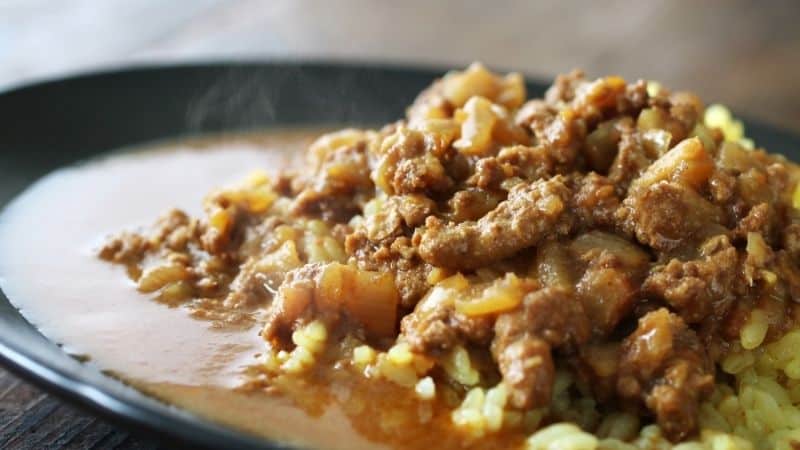
Keema curry is a medium to a hot curry made with minced beef that frequently includes peas. Other types of minced beef, such as lamb or mutton, can be used, and some recipes incorporate potatoes, making it similar to a Shepherd’s Pie filling, albeit a spicy one.
Is Curry Healthy?
Due to the different nutritious spices, curry powder may provide several health benefits. Here are some of the positive health effects from consuming curry:
It Has The Potential To Promote Brain Health
Curcumin, the primary ingredient in turmeric, has been shown in animal and human studies to enhance signs of mental decline and reduce the risk of acquiring Alzheimer’s disease.
Prevents The Development Of Cancer
Curcumin, a well-known healthful
Defending Against Bacteria
The antimicrobial properties of coriander are well-known. Coriander oil has been advised by experts in the fight against hospital infections and foodborne diseases, so eating curries on a daily basis may also help you avoid hazardous bacteria.
Helps With Digestion
Cumin, bay leaves, black pepper, cinnamon, and coriander are all good for reducing gas, bloating, diarrhea, and other digestive issues.
FAQs
Is It Possible To Add Curry Powder After The Dish Has Been Cooked?
You may receive varying flavors depending on whether it’s introduced early or late in the cooking process, and if it’s been roasting for a long time, you may get an unpleasant raw
How Can You Make A Curry Thicker?
Using cornstarch or plain wheat flour to thicken any sauce is also a simple and common method. Prepare slurry with two teaspoons of flour and enough water to produce slurry for every cup of liquid in your curry. Pour the mixture in a while, constantly stirring.
Conclusion:
Sweet spices like cinnamon and clove bring brightness and energy to the curry, while savory spices like turmeric, cumin, and bay leaf give it a deep, earthy flavor. Meanwhile if you’re simply craving a spicier taste for your curry, you can add chili peppers in any form that they come in. Hopefully, we helped you learn more about ways to enhance your curry experience!




